
We tested the best SUP paddles on the market from brands like Werner, Aqua Bound, Kialoa, NRS, and more, to help you find the right paddle for your paddling needs and budget. Photo: Nick Bruckbauer//The Inertia
Looking for the best SUP paddle? Whether you’re a beginner who’s testing the waters, a seasoned veteran looking for increased performance, or you’re just looking to upgrade the stock paddle that came with your inflatable paddle board kit, we’ve got you covered. Our veteran SUP experts researched 30 of the best SUP paddles on the market before selecting more than 20 models to put to a head-to-head test, and finally highlighting the 13 best options to present to you in this article.
Our team has been stand up paddle boarding for over a decade and has paddled everywhere from the open ocean to calm midwestern lakes to choppy alpine lakes and rivers. We put these paddles to the test across a summer of paddling on Lake Tahoe and in the surrounding alpine lakes, taking the time to weigh each paddle, test the adjustment mechanisms, and hit the water in a variety of paddling conditions. We also spent some time paddling the ocean and canals on Oahu, as well as the open ocean up and down the California coast.
Navigate To: Comparison Table | How We Tested | Buyer’s Guide
Related: Best Stand Up Paddle Boards | Best Inflatable Paddle Boards | More Paddle Gear Reviews
The Best SUP Paddles of 2025
Best All-Around SUP Paddle: Werner Zen 95
Best Blend of Performance & Value: Vamo Explorer
Best SUP Paddle on a Budget: Abahub 3-Piece Adjustable
Best High-Performance SUP Paddle: Werner Trance 95
Best Ultralight SUP Paddle: Quickblade Stingray 72
Best All-Around SUP Paddle
Werner Zen 95 ($300)
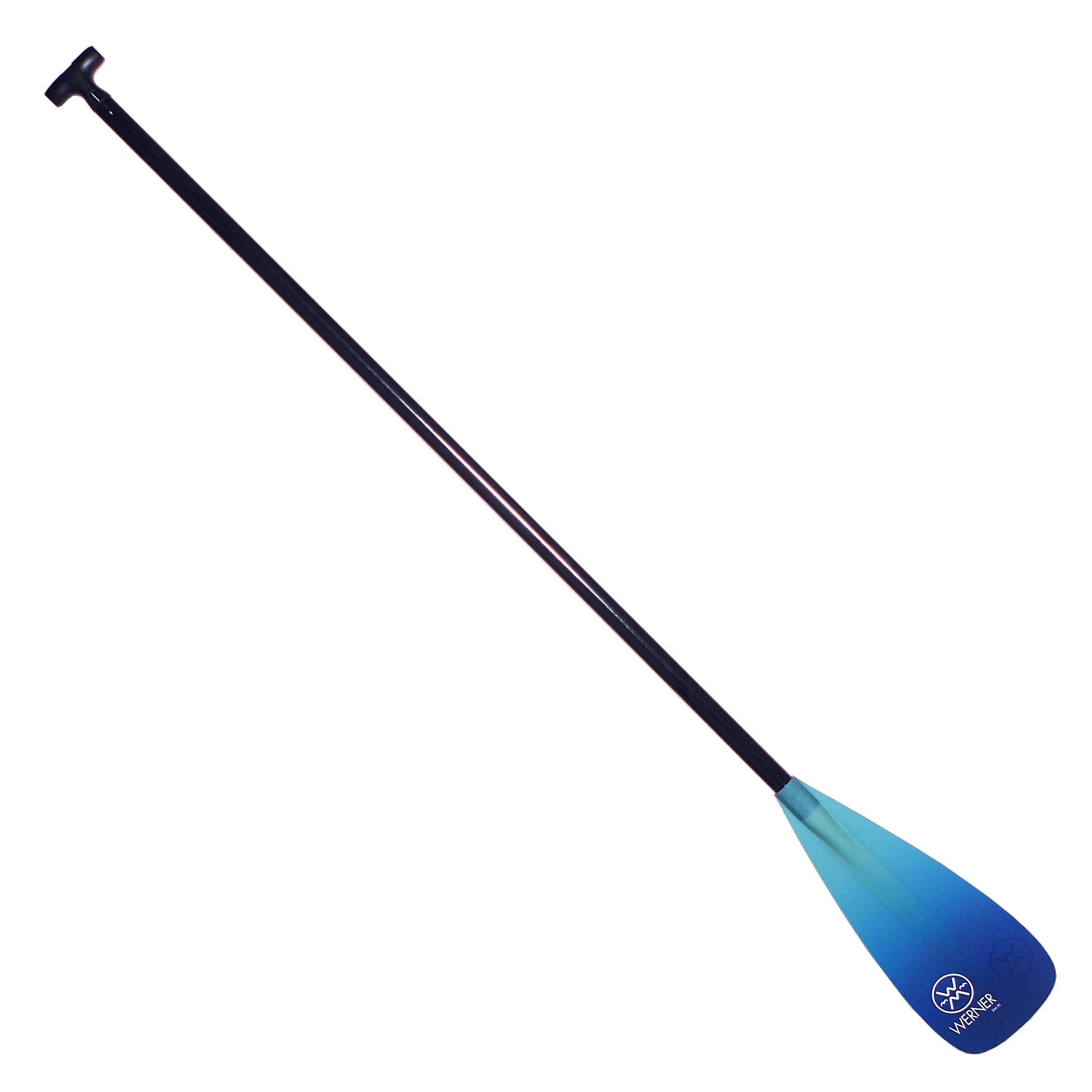 Available Styles: 1-Piece Fixed | 2-Piece | 3-Piece
Available Styles: 1-Piece Fixed | 2-Piece | 3-Piece
Measured Weight: 24.3 oz (2-Piece)
Shaft Material: Carbon/Fiberglass blend
Blade Material: Fiberglass
Pros: Includes LeverLock adjustment system with 16″ adjustment range, good stiffness, versatile blade shape, reasonably lightweight
Cons: Fairly expensive, not the lightest paddle
The Werner Zen 95 is our top recommendation for the best SUP paddle for most paddlers. It’s fairly lightweight at just over 24 ounces, has a stiff but not too stiff shaft and blade, includes our favorite LeverLock adjustment system, and has a versatile and forgiving blade shape.
The Zen’s LeverLock adjustment system provides fast and easy adjustability, excellent security when locked in place, and 16 inches of adjustability from 70 to 86 inches in total length. We also like that it allows infinite adjustment increments within that range. Some other designs — like the Aqua Bound models below — only allow length adjustments in 2-inch increments. With the LeverLock, simply open the lever, slide the handle to adjust the length, and close the lever to securely lock everything in place.
While other brands also employ the LeverLock adjustment system – like Kialoa on the Makai – we also prefer the Zen’s versatile blade design. At 95 square inches in surface area with 10 degrees offset, the stiff fiberglass blade has a tall and narrow shape, a rectangular bottom edge to improve paddling efficiency, and a slight dihedral face to make paddle strokes smoother and less “fluttery.” Some other paddles have wider blades with a flatter face that helps increase overall power, but the Zen’s design is more well-rounded for a wider range of paddlers and paddling conditions.
While perhaps a little on the pricey side with a list price of $300, the Zen 95 provides the best all-around blend of lightweight stiffness, the top-notch LeverLock adjustment system, and an optimum blade shape for most paddlers. If you’re looking for a similar but slightly cheaper option, the Vamo Explorer Carbon-Fiberglass Adjustable Stand Up Paddle is another great option, but it’s only available in a 2-piece model.
CHECK PRICE ON REI
The Werner Zen 95 is our favorite all-around SUP paddle, thanks to its forgiving blade shape, reasonably light weight, and awesome LeverLock adjustment mechanism. Photo: Nick Bruckbauer//The Inertia
Best Blend of Performance & Value
Vamo Explorer ($189)

Available Styles: 2-Piece
Measured Weight: 20.8 oz
Shaft Material: Carbon fiber/fiberglass blend
Blade Material: Carbon fiber
Pros: Good grip along the shaft, blade lined with soft plastic
Cons: Feels heavy despite its lower weight
Although the Vamo Explorer weighs just 20.8 ounces, it feels heavier than that when you pick it up. Made from a carbon fiber/fiberglass blend shaft and a carbon fiber blade, the adjustable paddle is made from high-quality, lightweight materials, so we’re stumped as to why our first impression was that it felt heavy. However, when you hit the water, the paddle performs well, delivering power with each stroke.
The Explorer two-piece paddle is fully adjustable, and it’s easy to make adjustments while on the water. Unlike cheap adjustable paddles, the Explorer sports a Never Twist V-Groove that prevents the shaft from moving while you paddle. The shaft has a good grip running its entire length, so you don’t have to worry about your hands slipping even when it’s wet. The edges of the blade are lined with a soft plastic that helps prevent damaging your board should you accidentally hit it while paddling. At $225, the Explorer is relatively affordable and delivers the performance of a pricier paddle. Another great pick from Vamo is the Vamo Full Carbon Fiber SR71.
If you’re looking for a paddle with a similar design and performance, the Werner Zen 95 is also incredible and comes in 1-piece, 2-piece, and 3-piece versions. Although the Explorer is four pounds lighter, it feels heavier to paddle than the Zen.
CHECK PRICE ON REI
Made from a carbon fiber/fiberglass blend shaft and a carbon fiber blade, the Vamo Explorer is fully adjustable and delivers efficient paddle strokes. Photo: Rebecca Parsons//The Inertia
Best SUP Paddle on a Budget
Abahub 3-Piece Adjustable Paddle ($35)
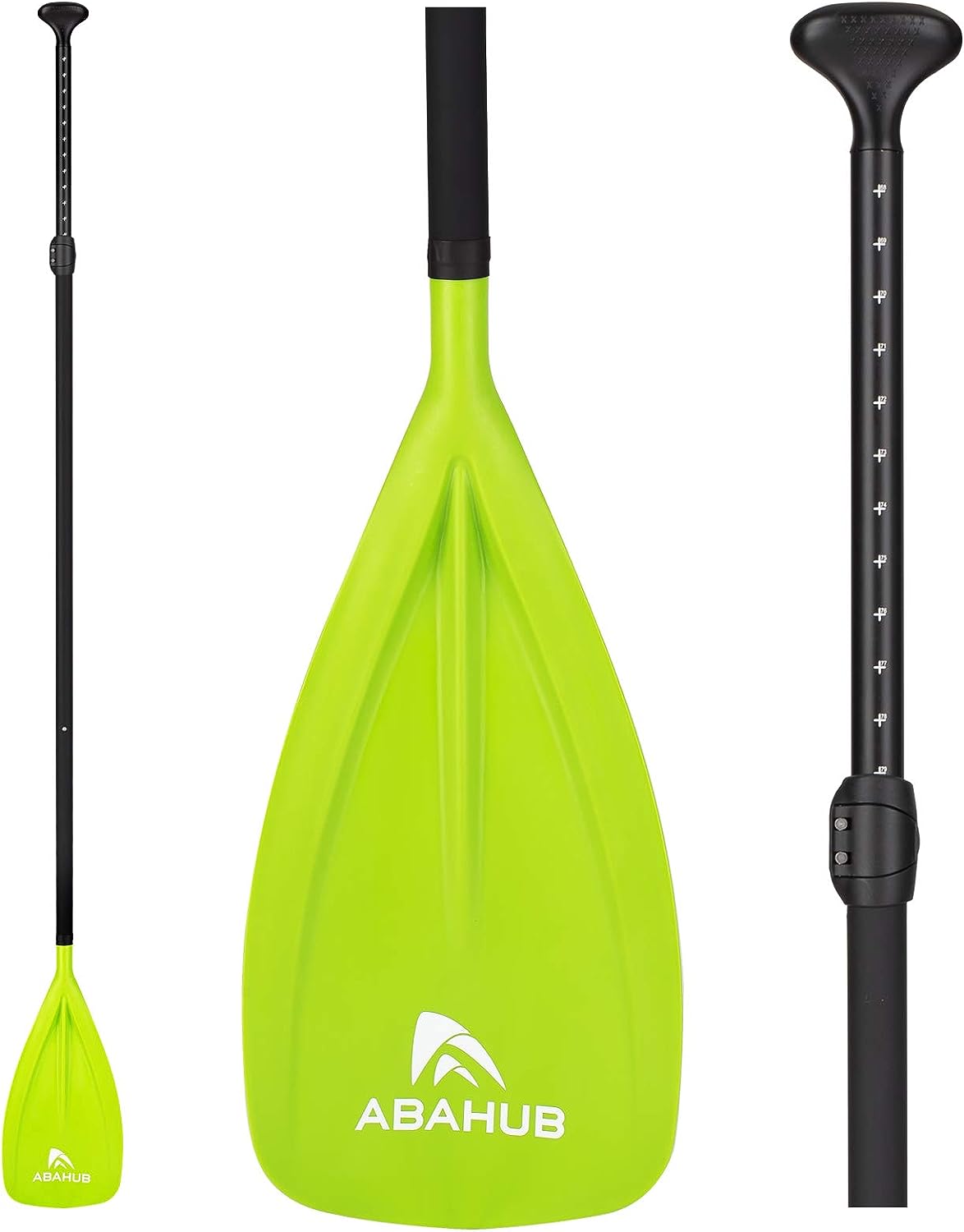 Available Styles: 3-Piece
Available Styles: 3-Piece
Measured Weight: 31.2 oz (3-Piece)
Shaft Material: Aluminum
Blade Material: Nylon
Pros: Excellent price, stiff aluminum shaft, easy to adjust with secure adjustment mechanism
Cons: Heavy, lower-grade materials than other models
The Abahub 3-Piece Adjustable Paddle is our choice for the best SUP paddle on a budget. While a bit heavier than other models and with more basic materials and construction, it can be snagged for under $40, making it a great choice for new paddlers, families, or anyone who is rough on their gear. The aluminum shaft is plenty stiff and durable, the cam-lock adjustment system is simple to use and secure, and the whole thing can come apart into three pieces for easy travel.
At this price point, most SUP paddles will have the same general materials and construction with an aluminum shaft and a nylon blade. There are some small variations in shaft, handle, or blade design, but the overall performance will be pretty similar. We chose the Abahub as our favorite budget option because it’s an ounce or two lighter than other models in this price range, has a simple and clean design, and a super affordable price.
The BPS Alloy 2-Piece is another great budget option, but it’s $30 more expensive and is a 2-piece paddle, so it’s not as packable. Both paddles feature an aluminum shaft, but the Abahub has a nylon blade, whereas the Alloy has a plastic blade.
CHECK PRICE ON AMAZON
The Abahub 3-Piece Adjustable Paddle is a great option for beginners or budget-minded paddlers. Photo: Nick Bruckbauer//The Inertia
Best High-Performance SUP Paddle
Werner Trance 95 ($408)
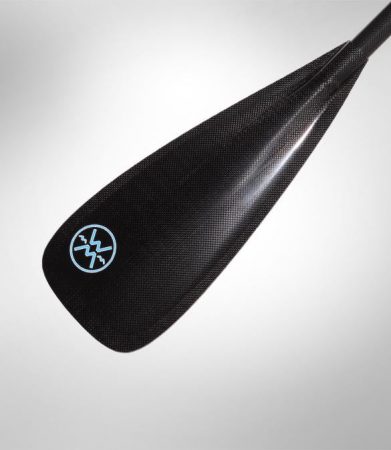
Available Styles: 1-Piece Fixed | 2-Piece | 3-Piece
Measured Weight: 19.8 oz. (2-Piece)
Shaft Material: Carbon
Blade Material: Carbon
Pros: Lightweight, stiff shaft and blade, smooth and efficient blade shape, clean aesthetics
Cons: Expensive
Whether paddle surfing, racing, touring, or paddling for fitness, experienced paddlers looking to optimize their on-water performance should look for a more performance-oriented paddle. The Werner Trance 95 is the best all-around high-performance SUP paddle we’ve tested. Weighing under 20 ounces in the 2-piece configuration, and with full carbon fiber construction in the blade and shaft, the Trance 95 is lightweight and stiff, and has a versatile blade shape that is both efficient and forgiving.
Compared to the Quickblade Stingray 72 — a similar high-end paddle with full carbon construction — we prefer the Trance 95 for its more versatile and forgiving blade shape. The blade catches in the water very smoothly and quietly, and has a slight dihedral ridge down the middle that keeps the paddle stroke smooth and stable through the water. The paddle feels light in your hands and through the water, and is a joy to use. The 2-piece and 3-piece versions also include the LeverLock adjustment system, which is our favorite adjustment mechanism we’ve used.
The most notable downside of the Trance 95 is its hefty price tag. While the price is in line with other premium products, it’s definitely an investment that is likely best reserved for experienced paddlers or progressing enthusiasts. And it’s worth noting that all lightweight carbon fiber paddles, like the Trance, are a little more fragile than cheaper and heavier nylon and aluminum paddles, so we recommend using care during transport or use.
CHECK PRICE ON REI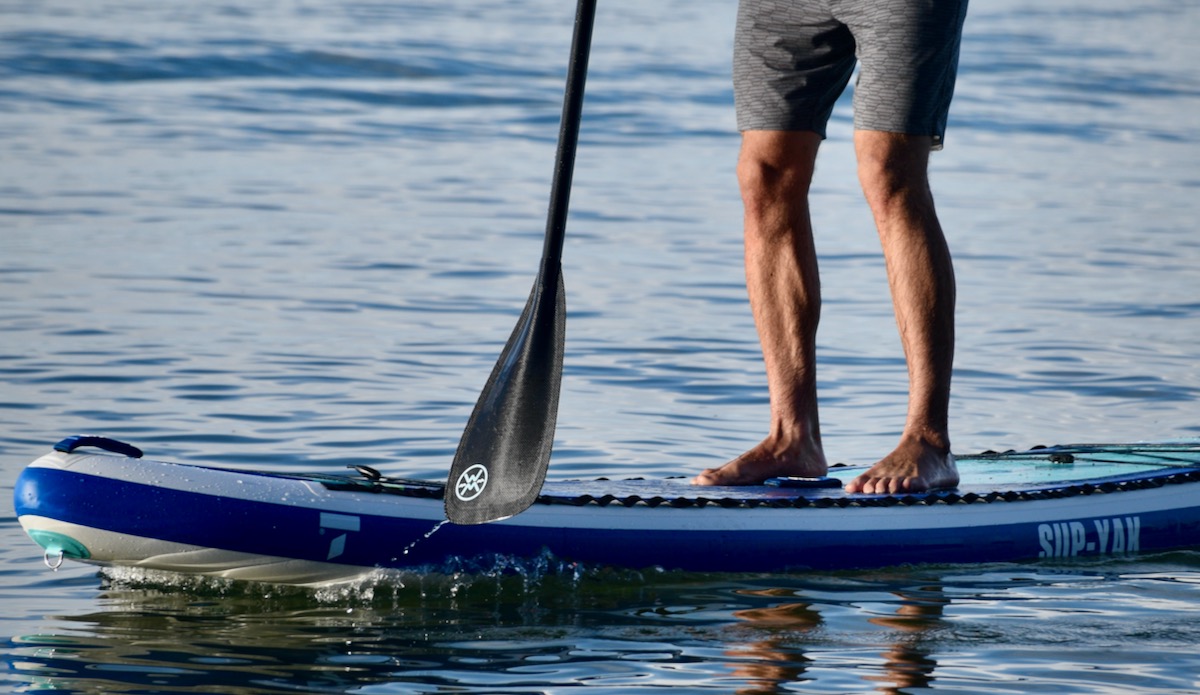
The Werner Trance 95 is stiff, lightweight, and has an efficient and forgiving blade shape. Photo: Shannon Bruckbauer//The Inertia
Best Ultralight SUP Paddle
QuickBlade Stingray 72 ($629)
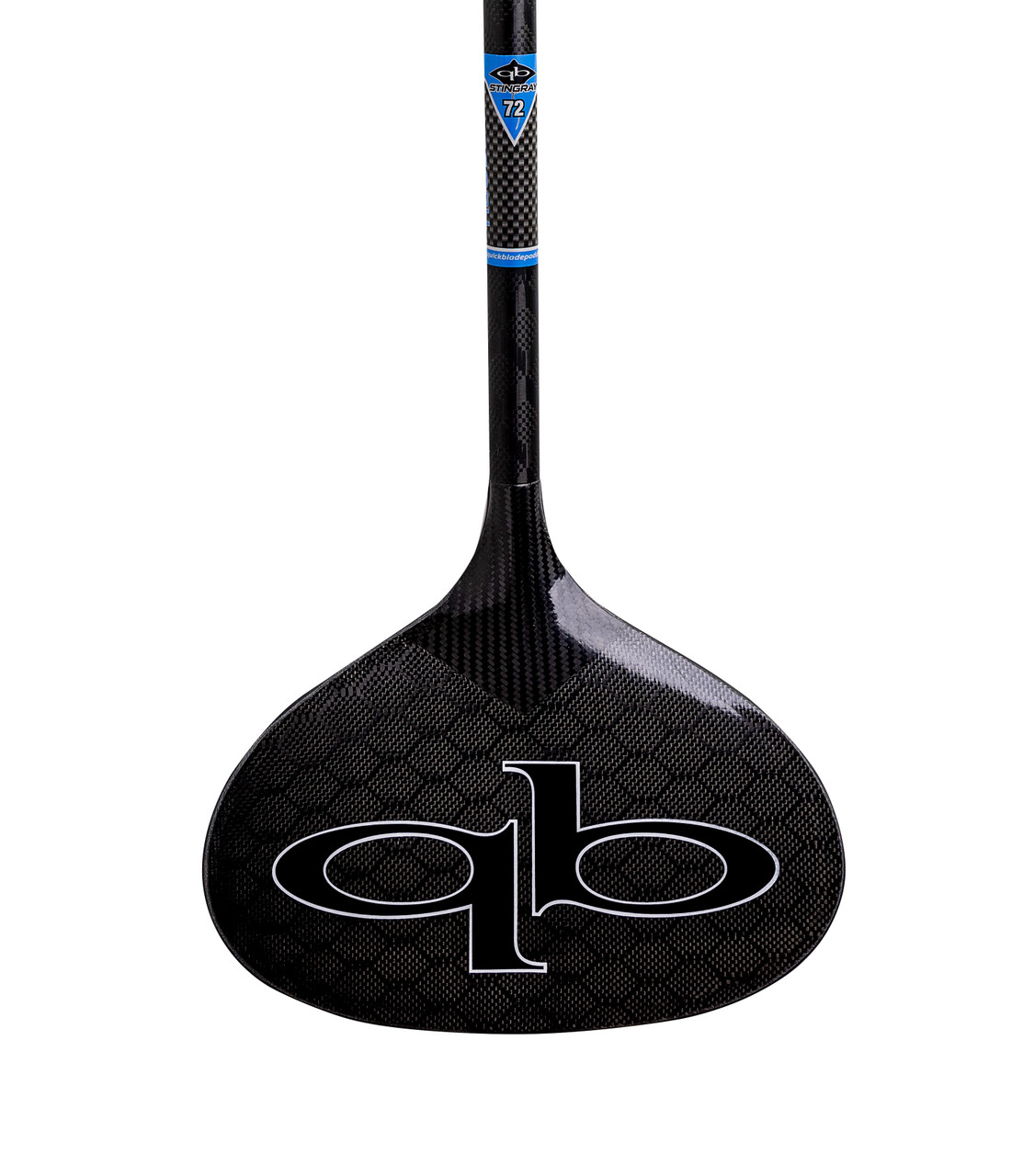
Available Styles: 1-Piece Fixed | 2-piece
Measured Weight: 15 oz (10″ blade)
Shaft Material: Carbon
Blade Material: Carbon
Pros: Extremely lightweight, delivers an efficient paddle stroke, adjustable
Cons: Expensive
The price tag on the QuickBlade Stingray 72 paddle is high, but it is among the best paddles we’ve ever tested in terms of quality of construction and performance. It features a carbon shaft, carbon blade, and weighs just 15 ounces.
You’ll notice that the shape of the blade on the Stingray is unlike any of the others on our list. The revolutionary new shape is unique to QuickBlade. The blade itself is only 10 inches long, which is roughly half the length of traditional blades, and it has a thin foiled shape that, at a 12-degree angle to the shaft, is designed to have some “winged” effect. In short, this unique design helps cut down on your catch and exit time and gives you extra time on the power length of your stroke, helping to propel you forward with speed.
When we first tried the Stingray, we worried that the wider blade would result in us banging it against the side of our board as it entered and exited the water. Luckily, this wasn’t the case. The combination of the lightweight carbon fiber paddle with the unique Stingray blade shape allows you to paddle incredibly efficiently, reducing fatigue and allowing you to paddle faster for longer periods of time.
The carbon fiber shaft has some texture to it that helps prevent your hands from slipping, and it is adjustable, so the paddle can be used by a wide range of paddlers. Finally, the hollow carbon palm grip felt good under our hands and helped prevent the paddle from slipping out. The paddle works well for both foilers and flat water paddlers.
While the Stingray is an incredible paddle, it is quite pricey and has a very specialized design that is geared towards performance athletes looking for the absolute best equipment to improve their overall performance. Because of this, we prefer the Werner Trance 95 as a better all-around high-performance paddle. The Trance 95 weighs a few ounces more but also has full carbon construction and a more traditional and versatile blade shape.
CHECK PRICE ON MACkite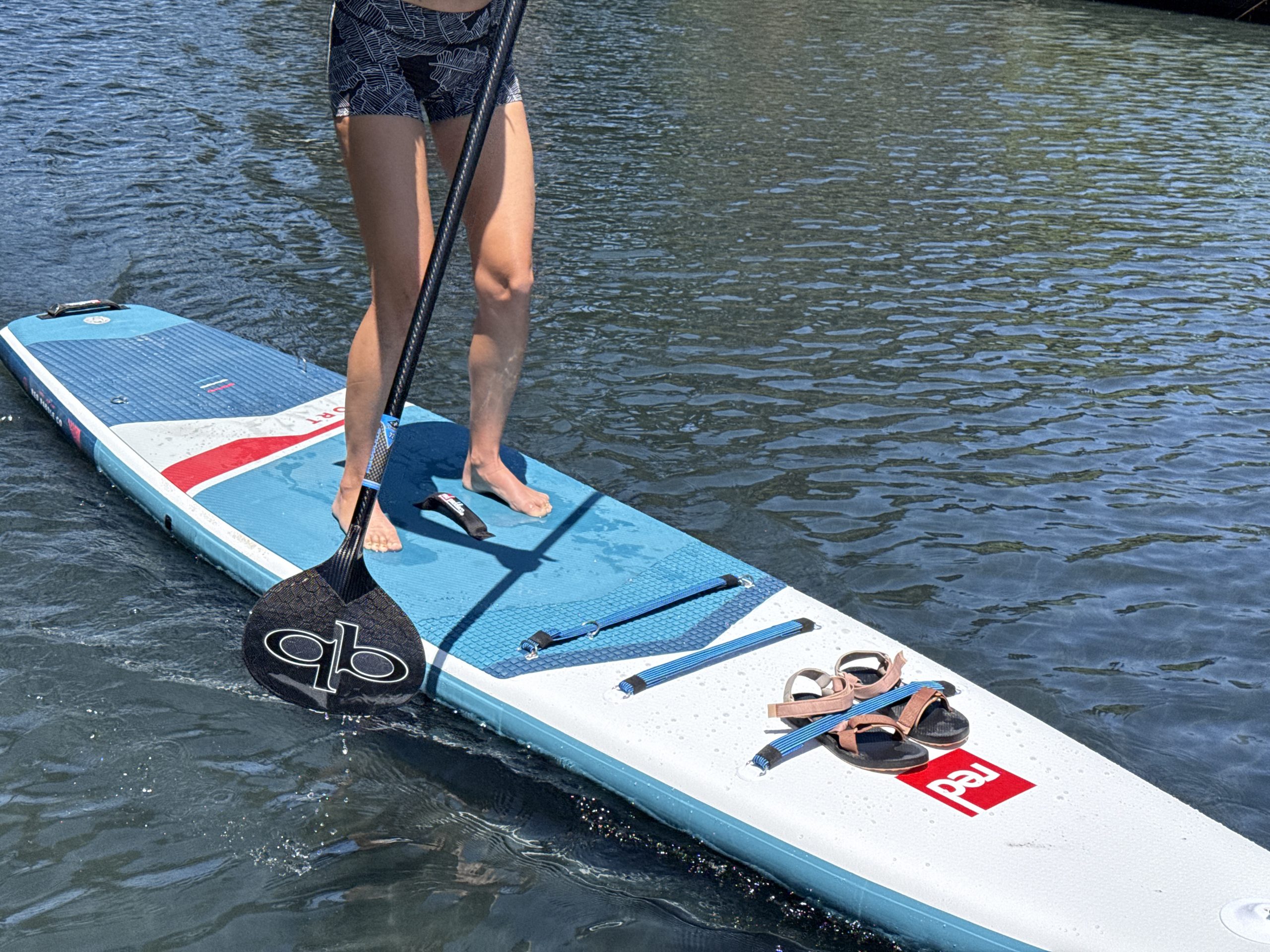
The unique blade design allows the QuickBlade Stingray to be incredibly efficient. Photo: Rebecca Parsons//The Inertia
More Great SUP Paddles
While the above top picks represent our highest recommendations for the Best SUP Paddles, we tested a wide assortment of paddles that are suitable for a wide range of budgets and paddling abilities.
One of the Lightest Fiberglass Paddles We’ve Tested
Aqua Bound Malta Fiberglass ($325)
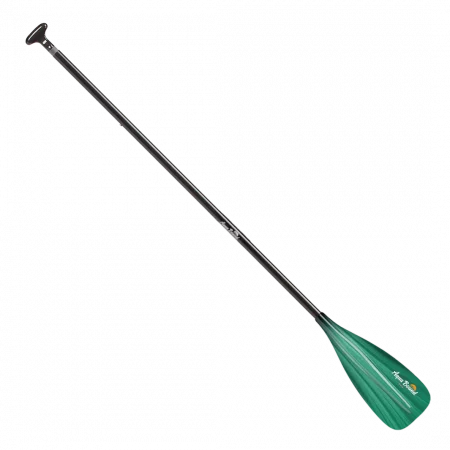
Available Styles: 1-Piece Fixed | 2-Piece
Measured Weight: 20.0 oz. (2-Piece)
Shaft Material: Carbon
Blade Material: Fiberglass
Pros: Very lightweight, quick and easy adjustment, versatile blade size and shape
Cons: Carbon fiber shaft is not as stiff as expected, can only adjust in 2-inch increments
The Aqua Bound Malta Fiberglass brings lightweight performance at a slightly more approachable price point with a carbon shaft and fiberglass blade. Despite the fiberglass blade, it is among the lightest SUP paddles that we tested.
However, this paddle has a few features that kept it from earning a higher overall ranking. The spring pin adjustment system – while super quick and easy to use – only provides 10 inches of total length adjustment in 2-inch increments, and doesn’t feel quite as locked-in as other adjustment systems like the LeverLock. We also thought the carbon fiber shaft was a little less stiff than we would have expected for such a high-end design.
Still, if you’re looking for a featherweight paddle that is enjoyable to use, the Malta Fiberglass would be a great choice. If you prefer a stiffer shaft, the Werner Zen 95 has a stiff shaft and a versatile blade, but it is also pricier.

The Aqua Bound Malta Fiberglass impressed us with its lightweight design and easy adjustment. Photo: Shannon Bruckbauer//The Inertia
Excellent Performance with Lightweight Construction
NRS Fortuna 90 Travel Adjustable Stand Up Paddle ($270)
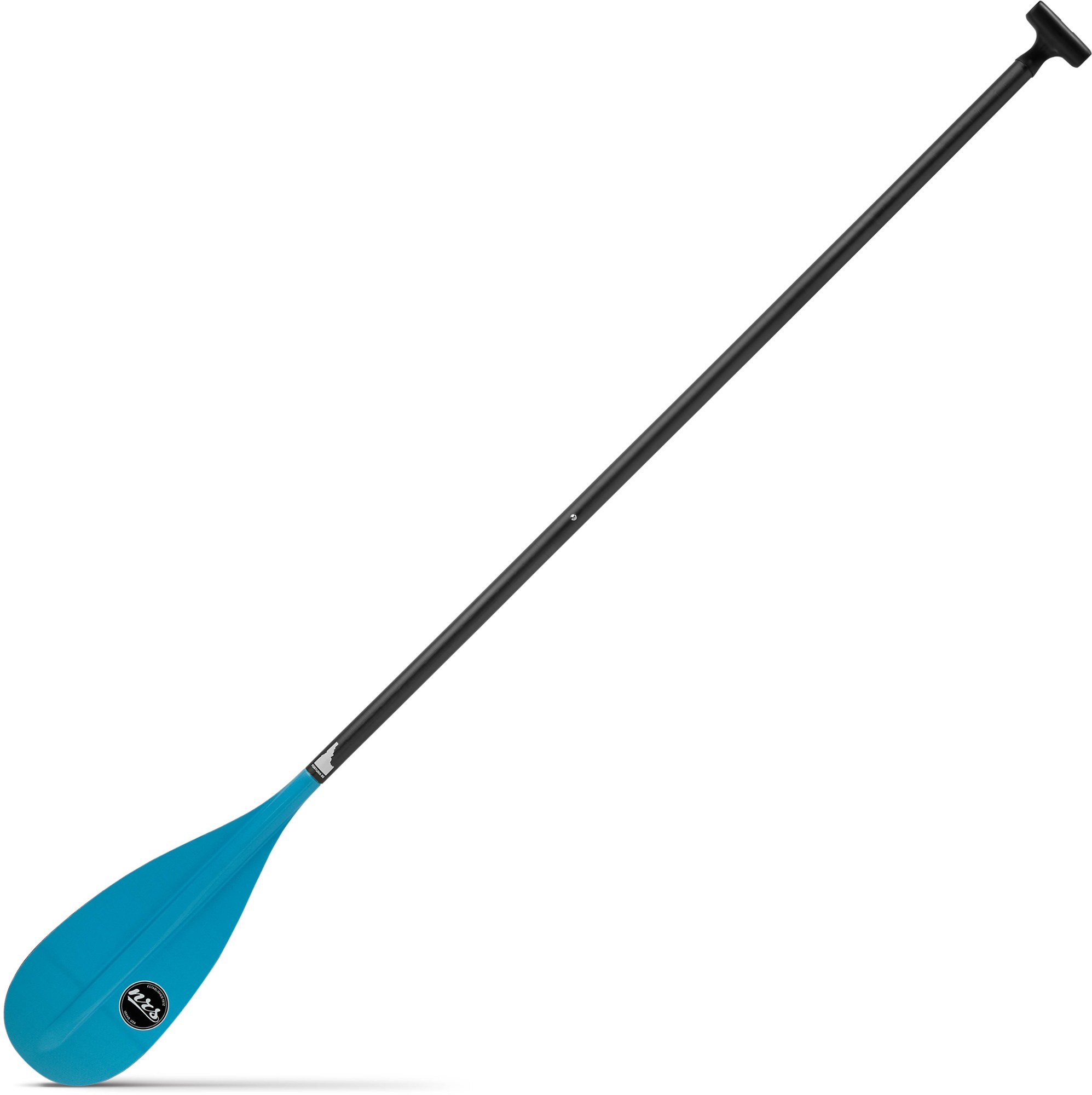
Available Styles: 3-Piece
Measured Weight: 23.2 oz
Shaft Material: Carbon-reinforced fiberglass
Blade Material: Fiberglass laminate
Pros: Delivers efficient strokes, rounded blade
Cons: Difficult to adjust
The NRS Fortuna 90 Travel Adjustable Stand Up Paddle is designed to be a one-size-fits-all paddle, regardless of where you’re headed. The paddle breaks down into two pieces, which is nice for when you have a tight fit. We think for it to be a true travel paddle, it should break down into three pieces, but that’s simply semantics.
Made from a carbon-reinforced fiberglass shaft and a fiberglass laminate blade, the Fortuna 90 is light for an adjustable two-piece paddle. Similar to the Werner Zen 95, in order to adjust the size of the paddle, you must undo the LeverLock system on the handle. Getting it open proved to be challenging, and we recommend finding your preferred size while on land, as on-the-water adjustments can be challenging, especially if you don’t have great finger strength. However, once you get it open, it’s easy to adjust and close, and it ensures the shaft doesn’t slide around while you paddle. The 10° offset allows for efficient strokes, and the slightly rounded blade helps prevent damage from run-ins with rocks.
CHECK PRICE ON REIAnother Great Mid-Tier SUP Paddle
Werner Vibe 2-Piece ($178)
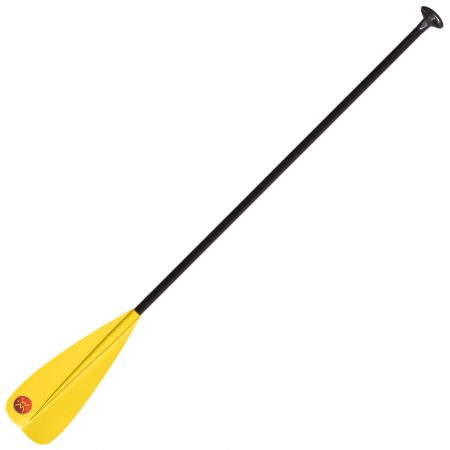
Available Styles: 1-Piece Fixed | 2-Piece | 3-Piece
Measured Weight: 30.7 oz. (2-Piece)
Shaft Material: Fiberglass
Blade Material: Fiberglass Reinforced Nylon
Pros: Versatile blade size and shape, top-notch LeverLock adjustment system, good stiffness and performance for a decent price
Cons: Noticeably heavier than other mid-tier options
The Werner Vibe combines several features from Werner’s higher-end paddles in a more affordable package, thanks to the use of slightly heavier and less premium materials. The Vibe shares the same LeverLock adjustment system as the top-ranked Zen 95 but has a fiberglass shaft and fiberglass/nylon blade compared to the Zen’s lighter-weight carbon/fiberglass shaft and fiberglass blade. Both paddles have a long, narrow blade shape with a flat bottom edge and a slight dihedral profile. This blade design is versatile and forgiving for different paddlers and paddling conditions.
The only notable downside of the Vibe is that it’s a bit heavier than some other mid-tier SUP paddles in its price range (9.7 ounces heavier than the NRS Rush (discontinued) and 6.2 ounces heavier than the Aqua Bound Freedom 85 ($170)). However, neither of these paddles has the LeverLock adjustment system that the Vibe has, which is our favorite overall adjustment system. The Vibe also has a very solid and durable feel, which, while a bit heavier, still makes it a fine option.
Solid Performance at a Reasonable Price
Kialoa Makai Fiberglass ($159)
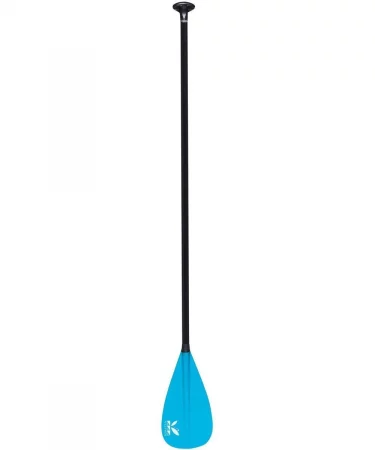 Available Styles: 2-Piece
Available Styles: 2-Piece
Measured Weight: 32.2 oz. (2-Piece)
Shaft Material: Fiberglass
Blade Material: Nylon Reinforced Fiberglass
Pros: Includes LeverLock adjustment system, nice dihedral blade shape, decent price
Cons: Fairly heavy
The Kialoa Makai is another solid mid-tier SUP paddle. The standout feature is the LeverLock adjustment system that we see on other higher-end Kialoa and Werner paddles. The LeverLock system allows infinite adjustments within a 16-inch adjustment range (from 70 to 86 inches in total length) and is the most secure adjustment system that we’ve tested. The Makai also has a traditional blade size and shape with a dihedral ridge through it that makes paddling a little smoother and more efficient.
The only notable downside of the Makai, like the Werner Vibe above, is that it’s a bit heavier than other mid-tier paddles. Part of this is due to the LeverLock adjustment system, which seems to add about 2 to 3 ounces to even the highest-end paddles, and the other part is the use of heavier-duty materials. Kialoa calls this their toughest SUP paddle, which would make it a great choice for families or users who are rough on their gear.
CHECK PRICE ON REIStrong and Durable Construction
NRS Bia 95 ($190)
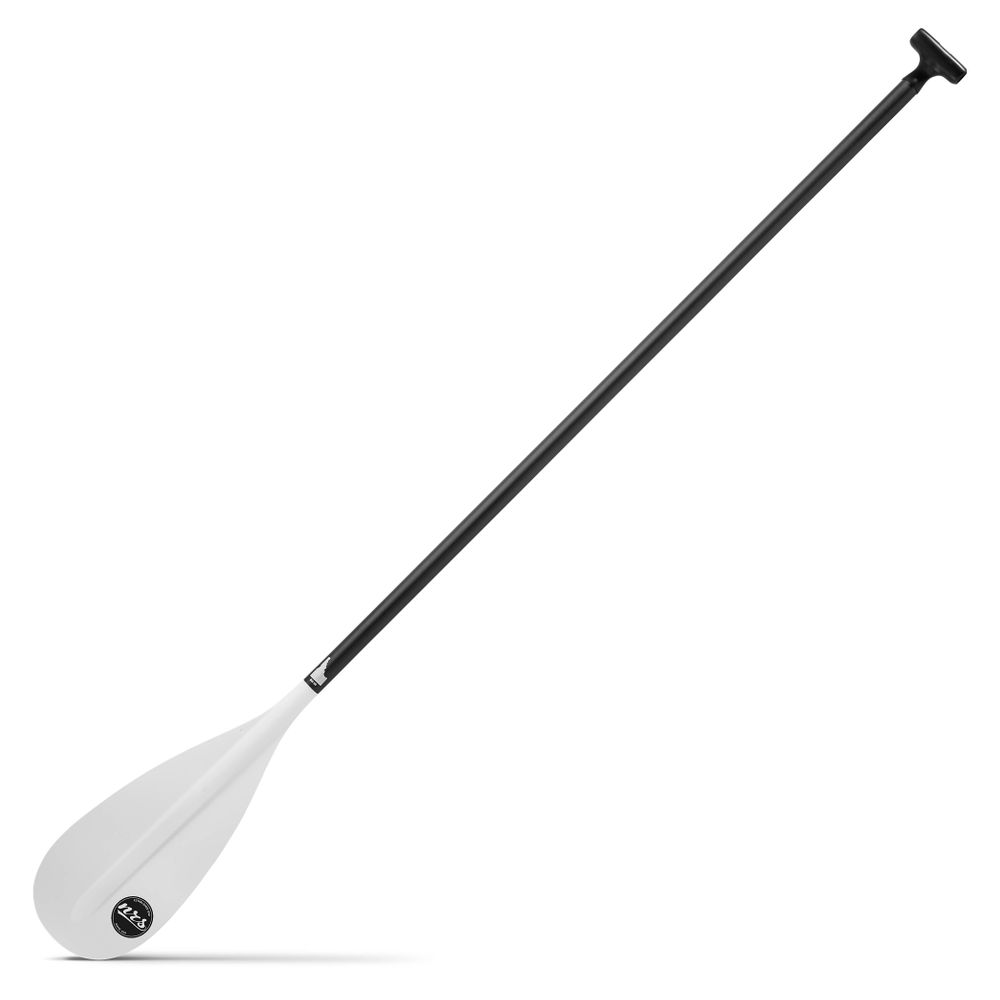
Available Styles: 2-Piece
Measured Weight: 29 oz
Shaft Material: Fiberglass
Blade Material: Fiberglass-reinforced nylon
Pros: Durable, LeverLock system ensures the shaft doesn’t slide around once you have it secured
Cons: Heavy, T-grip isn’t the most comfortable
Because most of NRS’s paddle boards are designed for the river, they make their paddles strong and durable. And the NRS Bia 95 is no exception. The Bia 95 sports a fiberglass shaft and a fiberglass-reinforced nylon blade, ensuring that it is strong yet flexible and durable enough to withstand some run-ins with rocks. The blade is also rounded, which further works to keep it intact should you scrape the bottom.
Although we didn’t have the opportunity to test the Bia 95 on the river, we were able to paddle it on flat water as well as on the open ocean. At 29 ounces, the Bia 95 is one of the heavier paddles on our list, but it doesn’t feel heavy while you’re paddling it. The 10-degree offset works to maximize efficiency through the power phase of each stroke. The smaller blade is easy to maneuver and navigate through the water, making you feel like you have more control of your paddle and, therefore, your board.
The Bia 95 is adjustable and caters to individuals ranging from 68″ to 84″. The paddle features a LeverLock system that you simply pull up on, and then you can adjust the paddle to your preferred height and then secure it once again. This system ensures the shaft doesn’t slide around once you lock it, which we greatly appreciated.
Although we didn’t have any issues with this particular paddle, I’ve used LeverLock systems in the past that were extremely challenging to pry open. Be sure and rinse your paddle with freshwater to ensure this doesn’t happen. The paddle also features a T-grip, which we didn’t find to be the most comfortable, but some folks might love it. If you’re looking for a similarly priced paddle that doesn’t have a T-grip, the Vamo Explorer Carbon-Fiberglass Adjustable Stand Up Paddle is a great option. It’s slightly less durable but is also lighter, so it just depends on what your priorities are.
CHECK PRICE ON REIOne of the Lightest SUP Paddles Under $100
Vamo Utility Paddle ($75)
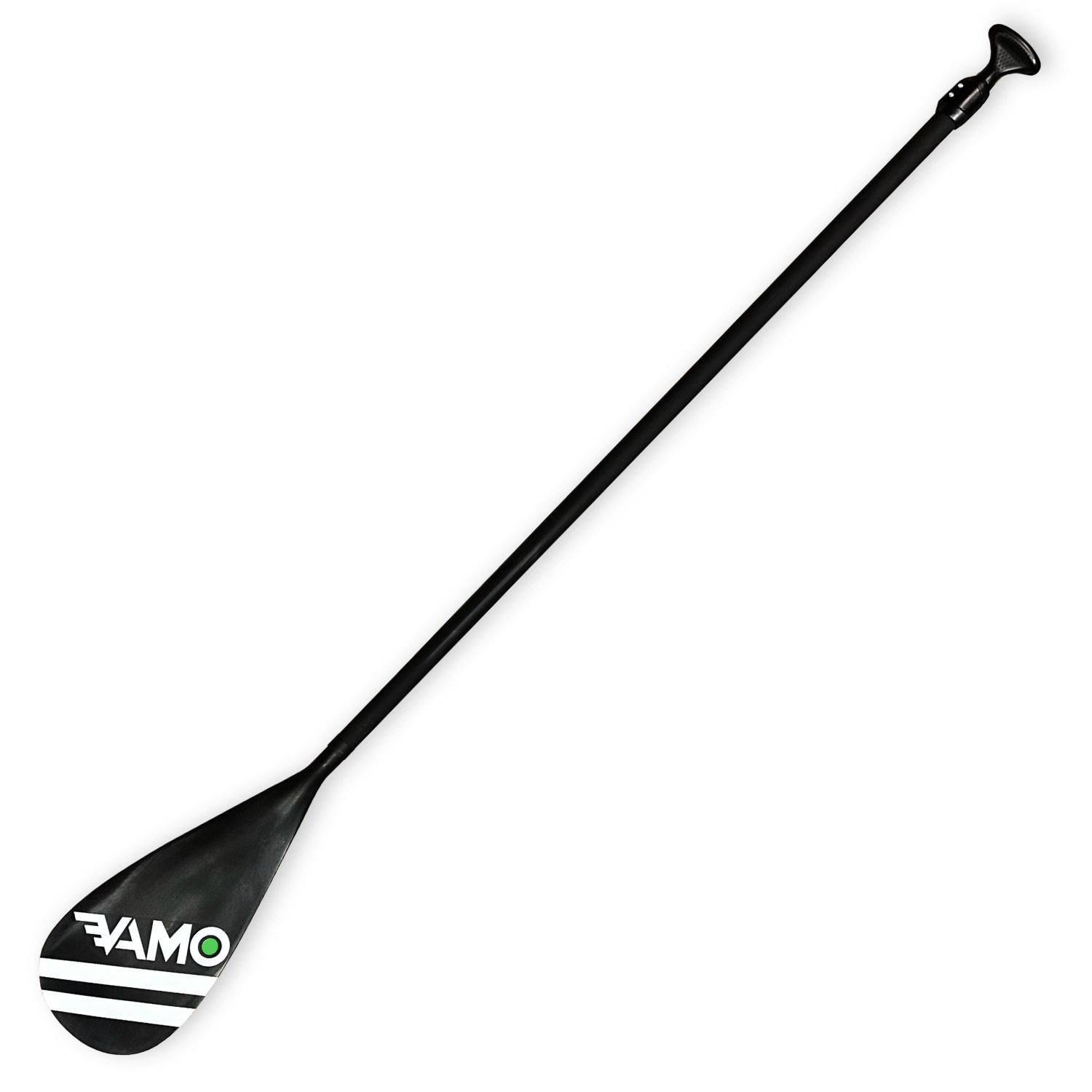
Available Styles: 2-Piece
Measured Weight: 24 oz
Shaft Material: Lightweight fiberglass
Blade Material: Rigid polypropylene
Pros: Lightweight, Easy to adjust
Cons: Grooves on the handle aren’t for everyone, blade feels too scooped
The Vamo Utility Paddle is an affordable SUP paddle that performs well. Featuring a lightweight fiberglass shaft and a rigid polypropylene blade, the Utility Paddle weighs just 24 ounces. Designed to work for kids and adults, the adjustable paddle caters to anyone between 68″ to 88″.
Two of our fears with budget SUP paddles it that the shaft won’t be secure and that the paddle won’t be very durable. Both of these fears are non-issues with the Utility Paddle. The paddle is easy to adjust – you simply flip open the locking mechanism and slide the shaft to your desired height. If, for some reason, your shaft is sliding around, simply tighten the screws to ensure it’s secure.
The handle on the paddle has small grooves in it that help prevent your hand from sliding around, which we felt like we could take or leave but some folks may love them Our only complaint about the Utility paddle is that the blade itself almost felt too scoped, taking away some of the power from your stroke – it’s something that only experienced paddlers would probably notice.
If you’re willing to shell out a little more money, the Vamo Explorer Carbon-Fiberglass Adjustable Stand Up Paddle is made from carbon fiber, allowing it to be about 4 ounces lighter. Or, if you’re looking for something even more affordable, the Abahub 3-Piece Adjustable Paddle costs just $35, but it’s not as high-performing as the Utility paddle.
CHECK PRICE ON REIMid-Tier Price with Basic Performance
Aqua Bound Freedom 85 ($180)
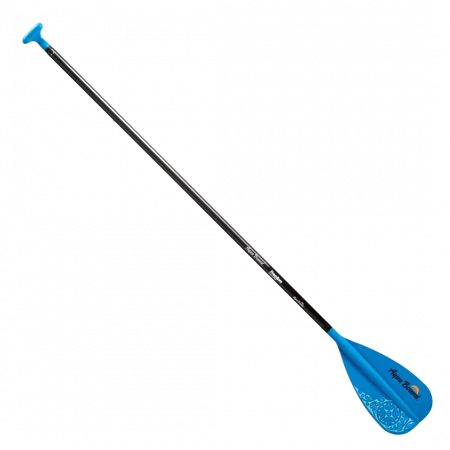 Available Styles: 2-Piece, 4-Piece
Available Styles: 2-Piece, 4-Piece
Measured Weight: 24.5 oz.(2-Piece)
Shaft Material: Carbon
Blade Material: EpX Engineered Polymer
Pros: Lightweight, carbon fiber shaft, easy adjustment system, forgiving blade shape, reasonable price
Cons: Blade is more flexible than we’d like, limited versatility with adjustment system
The Aqua Bound Freedom 85 is a great mid-tier paddle that benefits from a lot of the same design features as the higher-end Aqua Bound Malta paddles. It has a carbon fiber shaft, a simple spring pin adjustment system, and a fiberglass-reinforced polymer blade. The entire package comes in at 24.5 ounces, which is especially impressive considering its sub-$200 price tag.
The Freedom has a mid-sized 85-square-inch blade with a pretty pronounced dihedral shape (“v” shape), making it forgiving and less fluttery through the water. While the blade material is a little more flexible than we would like for performance-oriented paddling, all of these features make the Freedom ideal for newer paddlers. This would be a great, cost-effective upgrade to many of the low-end aluminum paddles that come with many inflatable SUP kits.
The Freedom is available in three different lengths, which are adjustable from 64 to 74 inches, 70 to 80 inches, or 76 to 86 inches. The spring pin adjustment mechanism allows adjustments in 2-inch intervals. This 10-inch adjustment range is less than the 16- to 18-inch range we see on most other paddles, so keep that in mind if you’re looking for a single paddle to share with both larger and smaller paddlers.
Best SUP Paddles Comparison Table
| Model | List Price | Measured Weight | Shaft/Blade Material | Adjustment Range |
| Werner Zen 95 | $300 | 24.3 oz | Carbon-fiberglass blend/Fiberglass | 70″ to 86″ |
| Vamo Explorer | $189 | 20.8 oz | Carbon and fiberglass/Carbon | 66″ to 88″ |
| Abahub 3-Piece Adjustable | $37 | 31.2 oz | Aluminum/Nylon | 68″ to 84″ |
| Werner Trance 95 | $408 | 19.8 oz. | Carbon/Carbon | 70″ to 86″ |
| QuickBlade Stingray 72 | $629 | 15.0 oz | Carbon/Carbon | 60″ to 78″ |
| Aqua Bound Malta Fiberglass | $325 | 20.0 oz | Carbon/Fiberglass | 64″ to 74″ 70″ to 80″ 76″ to 86″ |
| NRS Fortuna 90 Travel | $270 | 23.2 oz. | Carbon and Fiberglass/Fiberglass | 66″ to 84″ |
| Werner Vibe 2-Piece | $178 | 30.7 oz | Fiberglass/Fiberglassed nylon | 68″ to 84″ |
| Kialoa Makai Fiberglass | $159 | 32.2 oz | Fiberglass/Fiberglassed nylon | 70″ to 86″ |
| NRS Bia 95 | $190 | 29.0 oz | Fiberglass/Fiberglass-reinforced nylon | 68″ to 84″ |
| Vamo Utility | $75 | 24.0 oz | Lightweight fiberglass/Rigid polypropylene | 68″ to 88″ |
| Aqua Bound Freedom 85 | $180 | 24.5 oz | Carbon/Fiberglassed polymer | 64″ to 74″ 70″ to 80″ 76″ to 86″ |

In all, we tested over 20 different models before settling on the 13 best SUP paddles to include in the Buyer’s Guide. Photo: Nick Bruckbauer//The Inertia
How We Tested The Best SUP Paddles
After researching nearly 30 of the best SUP paddles on the market, we tested numerous different models before settling on the 13 best options to include in this Buyer’s Guide. Our team of experts and novices took to the water on Lake Tahoe and some of its surrounding alpine lakes. We put each paddle to the test in all kinds of conditions, from calm, glassy water to windy, wavy, choppy days with plenty of boat traffic to bounce us around. We tested the paddles on a variety of board types, including both hard boards and inflatable models, and both all-around recreational boards and longer, narrower touring models. We used each paddle in a comprehensive range of paddling conditions to identify its strengths and weaknesses and to help you find the right paddle for your experience level, paddling style, and budget.
Year-round Lake Tahoe resident Nick Bruckbauer leads our SUP paddle testing team. Nick has been stand-up paddling for over a decade since a trip to Hawaii in 2011 and has owned several different types of SUP boards and paddles since then. In addition to his current home waters of Lake Tahoe, he has paddled primarily on the Pacific Ocean while living in Santa Barbara, CA, for 10 years, but has also paddled a variety of lakes and rivers from the Midwest to the West Coast. Nick was joined in his testing by friends and family members with much less paddling experience to get their feedback, as well as other team members from The Inertia.
Our secondary tester was Oahu resident Rebecca Parsons. Rebecca has been stand up paddling since 2013, when she attempted her first race on a foam paddle board. Since then, she’s become a frequent paddler, regularly entering distance races, hitting the surf on her SUP, and cruising her local waterways with friends. Rebecca is originally from California but has lived in Hawaii for the past three years. She regularly travels back and forth, surfing and paddling different corners of the Pacific. Rebecca’s husband and friends helped with testing as well to offer perspective from a beginner paddler.

We put each of these paddles to the test in a variety of wind, weather, and water conditions. We also gathered feedback from friends and family with different experience levels to help you determine the best paddle for your needs. Photo: Nick Bruckbauer//The Inertia
We have been testing SUP paddles and updating this Buyer’s Guide since 2023. With continued testing through the summer of 2024 and into the cooler fall and winter months. We’ve added a handful of new picks and removed options that are no longer in stock. We once again updated this guide in the spring of 2025, getting rid of a few options that are no longer available and adding three additional paddles that we are testing and loving. Our latest update in September 2025 added one additional product to the lineup.
In addition to having owned and tested all kinds of SUP paddles from high-end featherweight carbon fiber models to heavier aluminum designs, Nick and Rebecca have also tested nearly 30 of the best inflatable paddles boards on the market over the last five years, as well as the best life jackets for paddle boarding. Nick went from a self-taught beginner to a confident paddling veteran and knows how to advise anyone from a true beginner to a true expert on the finer details of the best SUP paddles.

As a general rule of thumb, an ideal paddle length is approximately 6 to 10 inches above your height. Another way to check is to stand next to the paddle and reach up in the air, and make sure you can comfortably grasp the top handle. Photo: Nick Bruckbauer//The Inertia
How to Choose the Best SUP Paddle
Paddle Length
There are lots of tips, tricks, and formulas out there for choosing the best SUP paddle length, but in general, it ultimately comes down to personal preference and what feels most comfortable for you.
If you’re a beginner or intermediate paddler and you don’t have any idea what paddle length is right for you, we recommend starting with a 2-piece or 3-piece adjustable length paddle like the Werner Zen 95 or the Abahub 3-Piece Adjustable Paddle. This will allow you a little wiggle room to experiment with different paddle lengths and find what feels best for you based on the size and type of board you ride, your body type, and your typical paddling conditions.
It is usually recommended to use a paddle length that is approximately 6 to 10 inches above your height. This is a good starting point for general all-around paddling, and you can adjust from there as needed, depending on the type of paddling you do as well as the thickness and construction of your SUP board. An easy way to check this, if you don’t know your exact height or if the paddle doesn’t have length markings, is to stand next to the paddle and reach up in the air. You should be able to grasp the top handle with the palm of your hand.
For paddle surfing, your paddle may only be 2 to 4 inches above your height, since you’ll probably be in a lower, more crouched stance, and a shorter paddle will be easier to control for quicker, tighter maneuvers. For paddle racing, your paddle may be more like 8-12 inches above your head to give you more reach and leverage for optimum efficiency and power.
You may also want a slightly longer paddle with an inflatable board, since they are typically 6 inches thick or more, putting you ever so slightly higher above the water compared to traditional hard boards that are usually more like 4 to 5 inches thick.
Lead tester Nick Bruckbauer is 5 feet, 11 inches tall (71 inches), and typically uses an 80-inch paddle length (9 inches above his height) for general all-around paddling and touring on Lake Tahoe.
1-Piece, 2-Piece, or 3-Piece Construction
Once you have a reasonable idea of your preferred paddle length, the next step is to decide if you want a 1-piece, 2-piece, or 3-piece paddle. There are a few 4-piece or 5-piece paddles on the market, but they are rarer.
2-Piece Paddles
Most of the products we tested in this Buyer’s Guide are 2-piece adjustable paddles like our top pick and our runner-up, the Werner Zen 95 and the Vamo Explorer. This is the best blend of performance and versatility, with only a small weight penalty compared to 1-piece models, but typically with 10 to 16 inches of length adjustability. This makes them a great choice for groups or families who will be sharing one paddle, or for paddlers who typically paddle in different conditions or with different styles of boards.

Most of the paddles we tested are 2-piece designs. Photo: Shannon Bruckbauer//The Inertia
3-Piece Paddles
3-piece paddles will offer the same length adjustability as 2-piece models, but with the added bonus of breaking down into shorter pieces that make them easier to stow away for travel. Most inflatable paddle board kits include 3-piece models that fit comfortably within the included carrying bag. The only notable downsides to 3-piece models are that the extra connection points add a small amount of weight, and depending on the location and design of the connection points, they could potentially reduce shaft stiffness or place bulky connection hardware where you grasp the paddle shaft with your lower hand.
1-Piece Paddles
We would typically only recommend 1-piece SUP paddles for performance-oriented paddlers who mostly use the same type of board in the same type of conditions, and who have enough experience to definitively know their preferred paddle length. Competitive paddle surfers or SUP racers will likely use 1-piece paddles because they will be the lightest, strongest, and stiffest designs since there are no extra connection points or adjustment mechanisms.
While many 1-piece designs are sold at a specific length, many others are sold “uncut,” allowing you to cut the shaft to your exact preferred length before connecting the top handle.
Adjustment Mechanism
Since all of the best SUP paddles in our test lineup are adjustable 2- or 3-piece models, we paid close attention to the adjustment mechanisms. The design of these systems plays a big role in the ease and quickness of adjusting the paddle length as well as the security of how well the different shaft pieces are locked together
LeverLock
Our favorite overall adjustment mechanism is the LeverLock system that is found on all of the Werner and Kialoa paddles that we tested. This system is both quick and easy to use and is the most secure mechanism that we tested. It also offers “infinite” length adjustability (within a 16-inch range) where you can set the paddle to any exact length without being limited to certain spaced-out increments. The LeverLock system on the Werner Zen 95 is one of the reasons we gave it our top ranking over some other comparable paddles that weigh less but use different adjustment systems.
To open or “unlock” the system, you flip up a tensioned lever that is built into the paddle’s handle. This releases the tension of a small cable that is built into the shaft and allows you to freely slide the upper piece of the shaft back and forth. From there, you simply slide the upper piece up or down to your desired length and flip the lever down to lock everything in place.

To open or “unlock” the LeverLock system, you simply flip open the lever that is built into the top handle. Photo: Nick Bruckbauer//The Inertia
The upper shaft piece has convenient markings that show the paddle length measurements and help you properly align the top handle with the paddle blade. Once we closed the lever, we didn’t feel any wiggle or play between the two shaft pieces, even when pushing, pulling, or twisting them.

Showing the LeverLock system with the closed lever built into the top handle. The shaft of the Werner Zen 95 also has convenient length markings. Photo: Nick Bruckbauer//The Inertia
Camlock
The most common type of adjustment system we see is known as a camlock, collar clamp, or lever clip, like that found on the Vamo Explorer. This is the same type of lever that is typically found on adjustable ski or trekking poles. At the connection point between the two shaft pieces, a collar clamps around the shaft and can be loosened or tightened by opening or closing a lever.
These systems are pretty simple to use and are usually pretty reliable. We sometimes see some slipping or wiggling between the two shaft pieces that are connected with this system, but you can usually tighten the screw that holds the system in place to increase the overall tightness of the clamp.
Spring Pin
The last system that we tested is the spring pin system found on the Aqua Bound Paddles: the Aqua Bound Malta Fiberglass, and the Aqua Bound Freedom 85. This is probably the lightest and most simple system to use, but has some limitations with adjustments set at 2-inch increments, and only a 10-inch total length adjustment. (The Aqua Bound 2-piece paddles are available in three lengths: 64 to 74 inches, 70 to 80 inches, and 76 to 86 inches.)
The spring pin system is super easy to use. You simply push the spring-loaded button, slide the upper shaft piece up or down, and align the spring-loaded button with one of the preset holes in the lower shaft piece. This provides very precise length adjustments and ensures that the upper and lower shaft pieces are properly aligned. While this system helps make the Aqua Bound paddles among the lightest that we tested, it didn’t feel perfectly secure. If we tried to twist or pull at the two shaft pieces, we could feel a slight wiggle between them.

The spring pin adjustment system on the Aqua Bound paddles is very lightweight and easy to use, but leaves some small open holes in the main shaft piece, which can be distracting, depending on your hand placement. Photo: Nick Bruckbauer//The Inertia
Paddle Shaft Material
SUP paddle shafts come in one of three main materials: aluminum, fiberglass, or carbon fiber. Each material has advantages and disadvantages and impacts the weight, stiffness, and feel of the paddle, as well as its price.
Aluminum
Paddles with aluminum shafts are typically the least expensive. Aluminum is usually fairly stiff but is by far the heaviest of the three main shaft materials. It is also a good conductor of heat (and cold), and therefore can make the paddle feel uncomfortably cold to the touch in cooler air or water. Overall, paddles with aluminum shafts are an affordable and durable option, good for beginners who don’t want to spend a ton of money right away, or for families, summer camps, or rental shops where durability and economy are more important than lightweight performance. Our best budget pick, the Abahub 3-piece Adjustable Paddle, has an aluminum shaft.
Fiberglass
Fiberglass is one of the most common shaft materials for SUP paddles. Many of the best inflatable paddle board packages come with fairly decent paddles with fiberglass shafts and blades. Other inflatable boards come with heavier aluminum paddles, making a fiberglass model a solid and usually reasonably priced upgrade.
Paddles with fiberglass shafts typically have the best blend of performance, weight, and cost-effectiveness. Upgrading to carbon fiber can certainly increase stiffness and decrease weight for performance-oriented paddlers, but usually at a pretty steep cost.
SUP paddles with fiberglass shafts are usually pretty light and stiff, but keep in mind that there are different material grades and construction methods with fiberglass, so overall quality and stiffness can vary between different manufacturers or products. Both the Werner Vibe 2-Piece and the Kialoa Makai Fiberglass have fiberglass shafts and fiberglassed nylon blades for the ultimate blend of performance and durability.
Carbon Fiber
Carbon fiber is the highest-end shaft material; it is almost always the lightest and stiffest, as well as the most expensive. It also often has a recognizable and expensive (and in our opinion, great-looking) aesthetic with its woven material pattern. Similar to fiberglass, there are different material grades and construction methods with carbon fiber, so a carbon fiber shaft doesn’t always guarantee the best all-around performance.
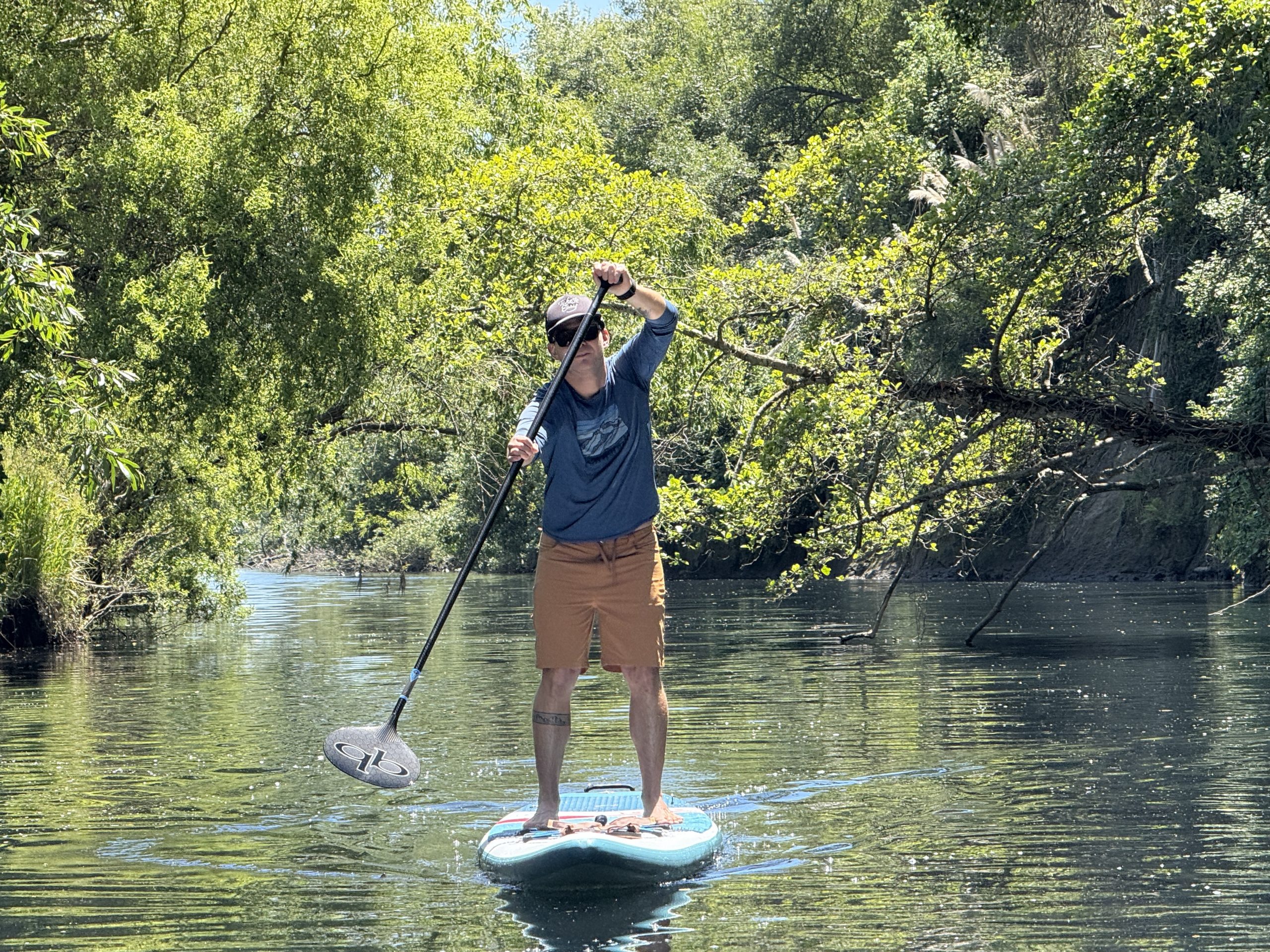
Carbon paddles like the QuickBlade Stingray All Carbon Hex are lightweight and high-quality. Photo: Rebecca Parsons//The Inertia
Most SUP paddle manufacturers don’t measure or rate the stiffness of their paddle shafts, so there really isn’t a precise way to directly compare the stiffness of different paddles or different materials (besides testing them head-to-head as we did!). Other factors like shaft diameter and material/wall thickness can also impact feel and performance, and these usually aren’t standardized or well-documented either.
For example, the Aqua Bound Malta Fiberglass boasts full carbon fiber construction in its shaft, yet feels like it has a much softer flex than the Werner Zen with its fiberglass/carbon hybrid shaft. While carbon fiber construction doesn’t necessarily provide the stiffest shaft flex, it does often indicate the lightest materials, and the Malta Fiberglass is one of the lightest paddles in our test at an impressive 20 ounces.
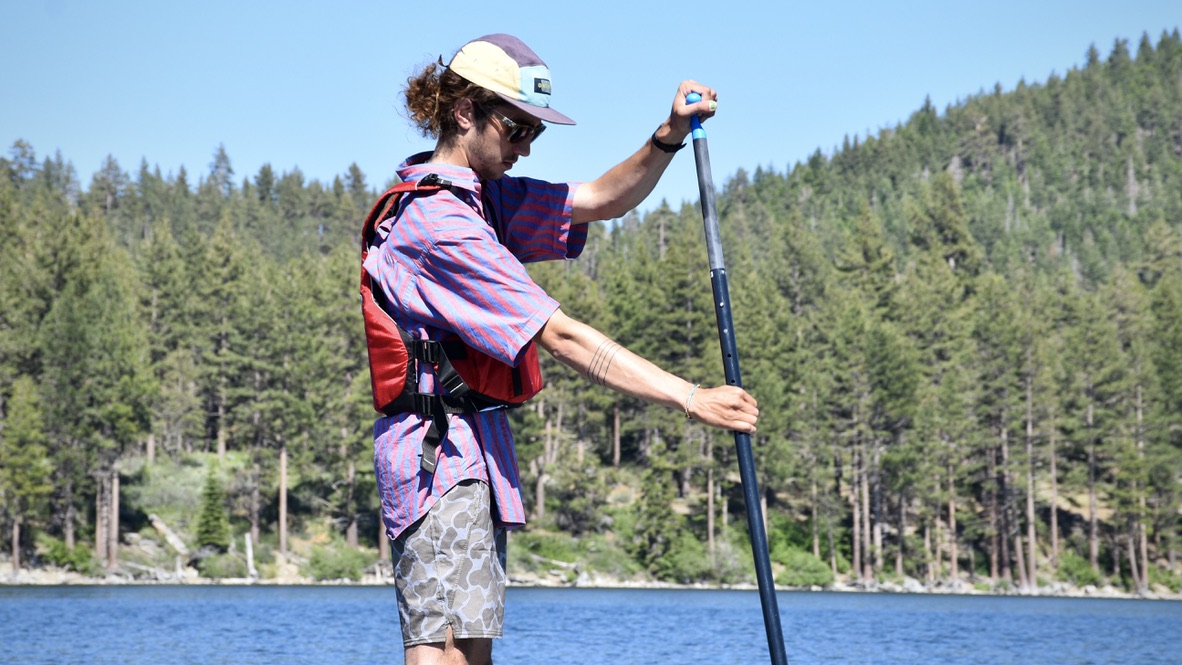
Most SUP paddles have a smooth shaft that can feel slippery if your hands are wet or sweaty. This shouldn’t cause any issues during casual paddling, but if you’re looking to paddle hard and fast, a slippery grip can become a problem. If your paddle’s shaft doesn’t have any texture and your hands are slipping, it can be helpful to apply a thin layer of surf wax to the shaft.
Blade Material
Similar to SUP paddle shafts, the blades typically come in one of three main materials that impact the price, performance, and durability of the paddle: nylon (or plastic), fiberglass, or carbon fiber.
Nylon/Plastic
Nylon or plastic blades are typically found on most entry to mid-level paddles. This material is less expensive to produce, and nylon blades are usually more flexible than fiberglass or carbon fiber, which makes them a little more forgiving for beginner paddlers, but can impact performance for more experienced paddlers. Nylon blades are usually a bit thicker and heavier than other materials, which can also impact performance, but can also make them more durable. Some high-performing mid-tier paddles like the Werner Vibe and the Kialoa Makai have nylon blades that are reinforced with fiberglass.
Fiberglass
Fiberglass paddle blades offer a step up in performance (and usually cost) over nylon blades because they are usually thinner, lighter, and stiffer. Similar to fiberglass shafts, there are different material grades and construction methods with fiberglass blades, so not every fiberglass blade will perform exactly the same. In general, fiberglass offers a nice blend of weight savings, stiffness, and all-around performance without the higher costs of carbon fiber.
Two of our favorite paddles – the Werner Zen 95 and the NRS Bia 95 – have stiff and lightweight fiberglass blades. Both models provide excellent performance at a reasonable weight and price tag.

The Werner Zen 95 has a beautiful fiberglass blade that is both lightweight and stiff and rivals the performance of carbon fiber. Photo: Nick Bruckbauer//The Inertia
Carbon Fiber
Carbon fiber is the highest-end blade material, and carbon fiber blades are usually only found on the most expensive performance-oriented paddles that prioritize weight savings and maximum stiffness. Carbon fiber blades are typically very thin, lightweight, and stiff, providing the most efficient power transfer from the paddler to the paddle to the water, but this also makes them a little less forgiving for beginner paddlers and a little more fragile than other heavier-duty materials.
Like any other material, there are different material grades and construction methods with carbon fiber, so two paddles with carbon fiber construction may not perform exactly the same. We’ve paddled a dozen or so carbon fiber-bladed paddles over the years and included two versions in this test: the QuickBlade Stingray 72 and the Werner Trance 95. Keep in mind that the most rigid paddle blade isn’t always necessarily the best. It will provide the most power and efficiency, but will also be less forgiving on the body since it requires more effort to power through the water.
Blade Size and Shape
Not all SUP paddle blades are created equally. Besides the material differences that we described above, blades come in many different shapes and sizes that can impact paddling comfort and performance.
Size
Subtle differences in blade size (the surface area of the blade) can have a big impact on your paddling experience. Think of the blade size like the gears on a bike. A smaller blade size (generally around 85 square inches or less in surface area) is like a lower gear on your bike. It will be comparatively easier to paddle, but it won’t provide as much power or energy transfer. Smaller blades can be more energy efficient for long-distance paddling, can provide quicker acceleration, and generally allow for a faster, higher-cadence paddling rhythm.
A larger blade size (generally around 95 square inches or more in surface area) is like a higher gear on your bike. It will be comparatively harder to paddle, but it will provide much more power and control. Larger blades are best for larger or stronger paddlers and for high-power output paddling styles like paddle surfing or river paddling, where quick, powerful maneuvers might be needed. Larger blades like those on the Werner Zen 95 (95 in2) can also suit paddlers who prefer a slower, lower-cadence paddling rhythm.
The sweet spot that is ideal for most people and provides the most versatility for variable paddling conditions is a medium blade size (generally between 85 and 95 square inches in surface area). The vast majority of the paddles we tested fall in or very close to this range. Medium-sized paddle blades provide a great blend of power and efficiency and are suitable for a wider range of paddlers, paddling styles, and paddling conditions. This is what we’d recommend for most people.
| Blade Size | Surface Area | Advantages | Disadvantages |
| Small | Less than 85 sq. in. | Easier to paddle, quicker acceleration, higher-cadence rhythm | Less power and energy transfer |
| Medium | 85 to 95 sq. in. | Best blend of versatility, power transfer, and efficiency | Might not perform as well in certain situations as a dedicated larger or smaller blade |
| Large | More than 95 sq. in. | More power and energy transfer, better leverage, lower cadence rhythm | Harder to paddle, less forgiving |
Shape
Not only do paddle blades come in different sizes, but two paddles with the same surface area may have different shapes that can impact their performance.
Some paddle blades are taller and narrower and usually have a more rectangular bottom edge. Regardless of the overall blade size, these paddles typically perform more like a smaller-bladed paddle, meaning they are easier to paddle and more efficient.
Other paddle blades have a more traditional teardrop shape that is shorter and wider, with a more rounded bottom edge. These paddles typically perform more like a larger-bladed paddle since more of the blade is in the water more quickly, meaning they may be a little more difficult to paddle, but will be more powerful.
The power face of the paddle blade (meaning the side of the blade that pushes against the water as you’re paddling) can also have different shapes or profiles. Some blade faces are completely flat, while some have a slight arc or scoop, while others, like the Werner Zen 95 and Werner Trance 95, have a dihedral ridge in the middle that makes the blade into a subtle V-shape. And the QuickBlade Stingray 72 has a shape that is completely unique and performs incredibly well.

Showing the “power faces” of the Kialoa Pipes II (discontinued) (left) and the Werner Zen 95 (right). The Pipes II has a mostly flat face, while the Zen has a more pronounced dihedral ridge through the middle of the face. Photo: Nick Bruckbauer//The Inertia
A completely flat blade face will be the most powerful, but can be more difficult to paddle since it takes more effort to pull the paddle through the water without the blade twisting or fluttering. Flat blade faces are typically found on larger blade sizes that are intended for more powerful paddling, like surfing, racing, or river paddling.
An arc or scoop in the blade can help increase power and leverage through the water without requiring as much effort.
A dihedral blade face is often the most efficient. The subtle V-shape helps the blade cut through the water with less effort and can help increase efficiency and reduce twisting or fluttering. Most of the paddles we tested have some kind of dihedral design.
Offset
The offset of a blade is the amount that the paddle blade angles away from the paddle shaft. You’ll notice that almost every SUP paddle has some sort of offset. This subtle angle helps the blade stay in a vertical position during the most powerful phase of the paddle stroke, which helps optimize efficiency and power.
Most SUP paddles have around 10 degrees of offset between the blade and the shaft. This is a pretty standard design for all-around paddling, and we wouldn’t recommend scrutinizing offset too closely unless you’re looking for specific performance features. Some designs have a little less offset (which can increase leverage for quick and powerful maneuvers during surfing or river paddling), and some have more offset (which can improve efficiency for long-distance racing).

Highlighting the 10-degree offset angle between the shaft and the blade on the Aqua Bound Malta Carbon. Photo: Nick Bruckbauer//The Inertia
Weight
Paddle weight obviously plays an important factor in paddling performance and the overall comfort and enjoyment of your experience, but we wouldn’t recommend worrying too much about weight as the absolute most important factor. We’ve found that other factors like blade size and shape, and the adjustment mechanism for 2- or 3-piece paddles have as much, if not more, bearing on the overall paddling experience as weight does.
Our top overall pick, the Werner Zen 95, is only the fifth-lightest paddle in our test group, but we favored it because of its awesome LeverLock adjustment system and its versatile and forgiving blade shape. Most paddles in the 20- to 25-ounce weight range will feel pretty similar in the hands. Paddles that weigh 20 ounces or less will feel noticeably lighter, and paddles that weigh in the upper 20- to low-30-ounce range will start to feel a bit heavier.
The lightest paddle in our test lineup is the QuickBlade Stingray 72 at just 15 ounces.
Price & Value
Like in most outdoor gear categories, there is usually a pretty consistent relationship between price and performance with SUP Paddles. As you add stiffer and lighter materials or more complex adjustment mechanisms, the price will keep going up.
In general, the most affordable paddles will have aluminum shafts and nylon or plastic blades. These will be the heaviest options, but will usually be fairly durable and a reasonable choice for beginner paddlers or those who are tough on their gear. We’d recommend the Abahub 3-Piece Adjustable Paddle as the best and most reasonably priced budget paddle.
The most expensive paddles will have carbon fiber shafts and blades, and the most complex and efficient adjustment systems. They will almost always be the lightest, the stiffest, and the nicest looking. The Werner Trance 95 and the QuickBlade Stingray 72 are our favorite high-performance carbon fiber paddles, but they have pretty steep price tags to match their high-end quality and performance.
Paddles with fiberglass shafts and blades will typically provide the best blend of performance and value. Fiberglass paddles can be surprisingly lightweight and stiff and can offer similar performance as carbon fiber paddles with only a small weight penalty, but often a notable price savings. We’d highly recommend the Vamo Explorer as a great blend of price and performance. It’s one of the lightest and stiffest paddles we tested, but it costs nearly half the price of full carbon fiber paddles.
Return to Top Picks | Return to Comparison Table
Related: Best Stand Up Paddle Boards | Best Inflatable Paddle Boards | More Paddle Gear Reviews
Editor’s Note: We’ve also reviewed The Best Lifejackets for Paddleboarding. Need something to wear when paddling? Here’s our guide to The Best Board Shorts, The Best Sun Hats, and The Best Rashguards. For more gear reviews and features on The Inertia, click here.


